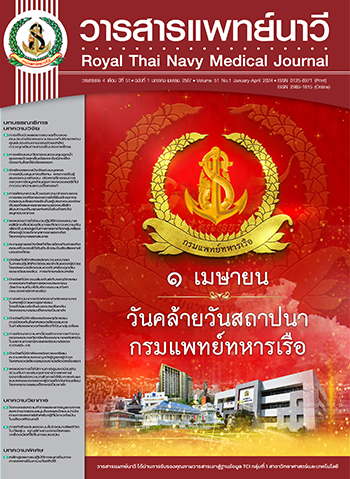Factors Associated with Exercise Behaviors among Working-aged People Using Naval Medical Department Sport Field
Main Article Content
Abstract
Non-communicable diseases are currently important problems in Thai public health system. Exercise behaviors can help prevent non-communicable diseases, promote good health, and prohibit disease in working-aged group. The PRECEDE-PROCEED model was applied in this cross-sectional study which aimed to study predisposing, reinforcing, and enabling factors related to exercise behaviors in working-aged group. During October - November 2023, two hundred thirty-two samples were collected through administered questionnaire which was divided into three parts, as followed: 1) personal and work factors; 2) predisposing, reinforcing, and enabling factors which showed content validity of 1 and reliability value between 0.86 - 0.94; and 3) exercise behaviors which showed content validity of 0.66 and reliability value equal to 0.89. The Pearson’s coefficient and Chi-square were used for analysis.
The result revealed that 17.24% of early working-aged people, 8.19% of late working-aged people, and 6.03% of middle working-aged people had high exercise behaviors. Predisposing factors such as education level, occupation, and work pattern were related to exercise behaviors with statistical significance at .05 (2 = 15.174, 32.093, and 20.821, respectively). Enabling factor including accessibility to sport field service (r = .217) was very low related to exercise behaviors among working-aged people using the Naval Medical Department sport field with statistical significance at .05.
Article Details

This work is licensed under a Creative Commons Attribution-NonCommercial-NoDerivatives 4.0 International License.
References
Division of Non-communicable Disease. Rate and incidence of five non-communicable disease 2021 [Internet]. [cited 2024 February 13]. Available from: http://www.thaincd.com/2016/mission/documents-detail.php?id=14480&tid=32&gid= 1-020. (in Thai).
Singhakowin T. Acedemic and research work in increase competency group for health promotion 2021. [Internet]. [cited 2022 February 13]. Available from: https://hp.anamai.moph.go.th/th/km-research-person/download/?did=204961&id=73867&reload=. (in Thai).
Budreviciute A, Damiati S, Sabir DK, Onder K, Schuller-Goetzburg P, Plakys G, et al. Management and prevention strategies for non-communicable diseases (NCDs) and their risk factors. Front Public Health 2020;8:788.
Education Department. Exercise and sport survey of Thai population in 2020. [Internet]. [cited 2024 February 13]. Available from: https://www.dpe.go.th/manual-files-432891791793. (in Thai).
Noppasri R, Heemrab S, Saisri A, Sopon A, Potisan K, Suwannarat P, et al. The satisfaction of the people towards the use of the new stadium of Songkhla Rajabhat University. Journal of Humanities and Social Sciences, SKRU 2020;2(1):99-128. (in Thai).
Somnil P. The experience of barriers affecting exercise adherence of university students in upper northeastern, Thailand. J Sports Sci Technol 2015;15(2):201-9. (in Thai).
Srichok K, Pluemsamran T, Chomsahai S. Exercise behaviors of working–agepopulation using exercise facilities in Chiang Mai province. Academic Journal of Thailand National Sports University 2023;15(2):147-58. (in Thai)
Sridawruang C, Worawong C, Sriyasak A, Howharn C, Manassatchakun P. Relationships between knowledge, attitude, and behavior toward food consumption and physical exercises among rural overweight middle-aged adult. Regional Health Promotion Center 9 Journal 2020;14(35):464-82. (in Thai).
Sirisom N, Leerapan P, Kengganpanich T, Kengganpanich M. Factors related to exercise behavior among officers in Suanchitralada, Dusit Palace. Journal of Health and Nursing Research 2014;30(1):34-44. (in Thai).
Junwin B, Dissara W. Influencing factors of exercise in working people in Nakhon Si Thammarat province. Nakkabut Parithat Journal 2019;11(3):1-9. (in Thai.)
Green LW, Kreuter MW. Health program planning: an educational and ecological approach. 4th ed. New York: McGraw-Hill; 2005.
Faul F EE, Lang A-G, Buchner A. G* Power 3: a flexible statistical power analysis program for the social, behavioral, and biomedical sciences. Behav Res Methods 2007;39(2):175-91.
Sritongtum J. Factors affecting exercise behavior of people excercising at Lumpini park Bangkok. [Master’s Thesis, Faculty of Physical Education]. Srinakharinwirot University; 2007. (in Thai).
Kusinitz I, Fine M. Your guide to getting fit. 3rd ed. California: Mayfield Publishing; 1995.
Namnuae S, Junprasert S, Rattanagreethakul S. Effects of self-regulation program on body weight, attitude, and walking exercise behavior among overweight female health volunteers. The Journal of Faculty of Nursing Burapha University 2023;31(1):30-41. (in Thai).
Moungsirithum P. Factors Influenced on physical movement of Faculty Of Physical Education Student at Srinakharinwirot University. Srinakharinwirot Research and Development Journal in Humanities and Social Sciences 2019;11(2):141-61. (in Thai)
Hinkle DE. Wiersma W. Stephen G. Applied statistics for the behavior science. New York: Houghton Muffin; 1998.
Mishra P, Pandey CM, Singh U, Gupta A, Sahu C, Keshri A. Descriptive statistics and normality tests for statistical data. Ann Card Anaesth 2019;22(1):67.
Hengruamyat C, Pichayapinyo P, Lakampun S. Predicting factors of maternal role in promoting child development aged 0 -2 years who receiving care at well–child clinics in Ratchaburi province. Royal Thai Navy Medical Journal 2023;50(1):29-42. (in Thai).
Najafi A, Safari-Faramani R, Selk-Ghaffari M, Najafi F, Ghafouri M, Darbandi M, et al. Comparison of the physical activity levels between shift workers and non-shift workers in a large-scale cross-sectional study in Iran. BMC Public Health 2023;23(1):2034.


